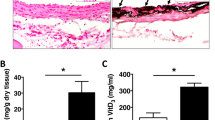Abstract
In an attempt to clarify data obtained from animal models of intimal hyperplasia, we used New Zealand white rabbits, a standardized balloon catheter injury model, and a 0.25% cholesterol supplemented diet. The effects of mechanical injury and hyper-cholesterolemia separately and combined were determined at the carotid and iliac positions at 12 weeks. En-face planimetry of lesioned intima and measurement of transverse intima-to-media thickness were taken as indices of intimal hyperplasia. No animals received antiplatelet agents or postoperative anticoagulation and all vessels remained patent. Neither procedure alone resulted in statistically significant lesion increase. However, combinations of injury and cholesterol resulted in statistically significant and synergistic lesion enhancement. The quantitative data, coupled with distinctive features noted on scanning electron microscopy and transmission electron microscopy, showed separate and synergistic effects of mechanical injury and cholesterol diet on intimal lesions in this model. Additionally, these effects must be considered in evaluation of animal models of intimal hyperplasia and atherosclerosis. Furthermore, this may help dissect mechanisms of failed revascularizations.
Similar content being viewed by others
References
CALLOW AD. Recurrent stenosis after carotid endarterectomy.Arch Surg 1982;117:1082–1085.
DEPALMA RG. Atherosclerosis in vascular grafts.Athero Rev 1979;6:147–177.
ECHAVE V, KOORNICK AR, HAIMOV M, et al. Intimal hyperplasia as a complication of the use of the polytetrafluoroethylene graft for femoral-popliteal bypass.Surgery 1979;86:791–798.
CHERVU A, MOORE WS. An overview of intimal hyperplasia.Surg Gynecol Obstet 1990;171:433–447.
CLOWES AW, REIDY MA, CLOWES MM. Kinetics of cellular proliferation after arterial injury. I. Smooth muscle growth in the absence of endothelium.Lab Invest 1983;49:327–333.
ROSS R. Cellular interactions, growth factors, and atherogenesis.Atherosclerosis Rev 1990;21:53–58.
HOLM J, HANSSON GK. Cellular and immunologic features of carotid artery disease in man and experimental animal models.Eur J Vasc Surg 1990;4:49–55.
WITZTUM JL. Current approaches to drug therapy for the hypercholesterolemic patient.Circulation 1989;80:1101–1114.
SOTTIURAI VS. Biogenesis and etiology of distal anastomotic intimal hyperplasia.Int Angiol 1990;9:359–369.
FINGERLE J, AU YPT, CLOWES AW, et al. Intimal lesion formation in rat carotid arteries after endothelial denudation in absence of medial injury.Arteriosclerosis 1990;10:1082–1087.
ROSS R, GLOMSET JA. The pathogenesis of atherosclerosis.N Engl J Med 1976;295:369–377.
ROSS R. The pathogenesis of atherosclerosis: an update.N Engl J Med 1986;314:488–500.
LIBBY P. BIRINYI LK, CALLOW AD. Functions of endothelial cells related to seeding of vascular prostheses: the unanswered questions. In:Endothelial Seeding in Vascular Surgery. New York: Grune & Stratton, Inc. 1987, pp 17–35.
LIBBY P. Inflammatory and immune mechanisms in atherogenesis.Atherosclerosis Rev 1990;21:79–89.
CARREL A, GUTHRIE CC. Results of the biterminal transplantation of veins.Am J Med Sci 1906;132:415–422.
LO GERFO FW, QUIST WC, NOWAK MD, et al. Down-stream anastomotic hyperplasia: a mechanism of failure in Dacron arterial grafts.Ann Surg 1983;197:479–483.
SELMAN SH, RHODES RS, ANDERSON JM, et al. Atheromatous changes in expanded polytetrafluoroethylene grafts.Surgery 1980;87:630–637.
ZIERLER RE, BANDYK DF, THIELE BL, et al. Carotid artery stenosis following endarterectomy.Arch Surg 1982;117:1408–1415.
GALLINO A, MAHLER F, PROBST P, et al. Percutaneous transluminal angioplasty of the arteries of the lower limbs: a 5-year follow up.Circulation 1984;70:619–623.
SPENCE K, FREIMAN DB, GATENBY R, et al. Long-term results of transluminal angioplasty of the iliac and femoral arteries.Arch Surg 1981;116:1377–1386.
CAMPEAU LC, ENJALBERT M, LESPERANCE J, et al. The relation of risk factors to the development of atherosclerosis in saphenous-vein bypass grafts and the progression of disease in the native circulation.N Engl J Med 1984;311:1329–1332.
Author information
Authors and Affiliations
About this article
Cite this article
Stevens, S.L., Hilgarth, K., Ryan, U.S. et al. The synergistic effect of hypercholesterolemia and mechanical injury on intimal hyperplasia. Annals of Vascular Surgery 6, 55–61 (1992). https://doi.org/10.1007/BF02000669
Issue Date:
DOI: https://doi.org/10.1007/BF02000669




